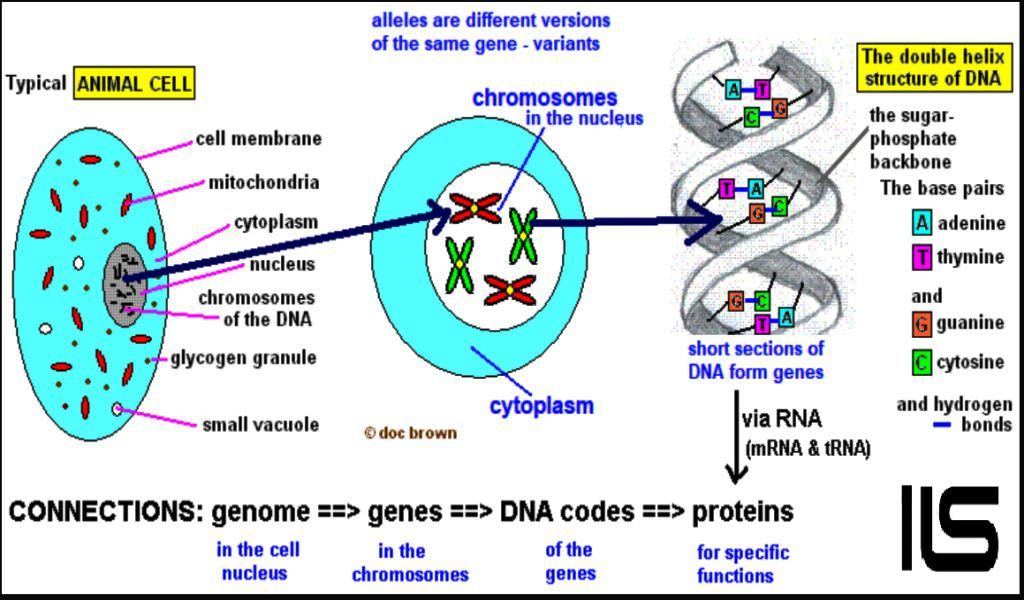FROM BODY CELL TO GENES & DNA
FROM BODY CELL TO GENES & DNA is an essay which explains from the beginning till end everything from the bigger level of a Cell to a smaller levels of GENES (ALLELES) & DNA.
- A human body is made up of cells. Each cell has a nucleus. Each nucleus contains tightly packed thread like structures – called chromosomes.
- In the human beings there are 23 pairs of chromosomes. A pair of chromosomes consists of two chromosomes so that each one of them is received from each of the two parents.

- Portions of the chromosomes are called Genes. A human being carries almost 20,000 to 25,000 genes in his biological structures called Genome. Hence, each chromosome contains roughly around 1000 genes on it.
- These portions of chromosome i.e. The Genes are made up of DNA.

- The structure of DNA consists of two spiral Helices (pl. of Helix) complimenting each other. The material of Helices of DNA is a set of sugar molecules, bonded to a phosphate group on one end and to a Nitrogenous base on the other. This is shown in the images below:

- In this image P is the phosphate group, S is the sugar molecule and A, C, G and T are the nitrogenous bases. Their names are A (adenine), C (cytosine), G (guanine), T (thymine). In the structure of DNA base A is always connected to base T, and base C to the base G. This basic building block of the DNA (containing Phosphate group P + Sugar S + Corresponding Nitrogenous Base A, C, G, T) is called a Nucleotide.
- In professional work, only the variable parts A, C, G and T are shown in place of full structure of a nucleotide. Hence, to represent the four basic building blocks of DNA i.e. the nucleotides only their representative letters A, C, G and T are used. They are also called base pair or bp.
- Now for the basic understanding, it can be said that the DNA is made up of a long chain of nucleotides or bp. In this long chain, the nucleotides (A, C, G and T) or any component thereof, i.e. the bps, repeat themselves randomly without any pre-defined order of occurrence.
- Logically, the internal structure of a DNA should appear as shown below:

- But practically, this is not so. The building block ATGC does not repeat in regular form because this will make the DNA of all living beings identical. To account for diversity of species and individual organisms, in long chains of DNA Helices, the building block ATGC or any component thereof, repeats itself in a random manner. This random repeat of the building block ATGC or any component thereof, creates different versions of DNA in a gene. These different versions of genes are called Allele.
- In the following example four Allele of any particular gene with 5, 7, 8 and 9 repeats of a building block ATG are shown

- In the following example the bp CTA is the tandem repeat:
- Another example of GATA tandem repeat:

- The repetition of building blocks in the DNA (an Allele of a gene) is called STR i.e. Short Tandem Repeats. These STR are random. There may be a repeat of two bp (i.e. base pair i.e. ATGC), three or four or five or more bp
- In the real situations the chromosomes are marked with specific numbers showing on which chromosome at which particular location the allele was searched e.g. D3S1358 represents Location 1358 On Chromosome No.3. D5S818 represents location 818 on chromosome No.5. The D3S1358 and D5S818 are called markers. Hence, a marker is a particular location on a certain chromosome. These markers are consisting of a particular allele.
- Through the mathematics of probability, it is almost certain that no two individuals can have similar STR on all 16 markers of the human genome. This method of STR is used pin point an individual from the remaining human race.
- The STR of the stain found on the crime scene is compared to STR of the admitted sample of the suspect. There should be a 100% match in STR at all legally admissible markers (Allele found at the specific location on a particular chromosome).
- When these STR are shown along a reference axis these are called STR profiles.

- These STR profiles are easy to comprehend and explain e.g. in the image above marker D3S1358 (On Chromosome No.3 at Location 1358) there is an allele of 14 STR repeats. And the marker D5S818 shows the 11 STR allele.
- Till December 2016 Americans used 13 specific STRs to pin-point the matching of a particular DNA. They name their set of DNA Markers as CODIS.

- Suspecting certainty of 13 DNA Markers the Americans after January 1, 2017 have adopted a system of 20 DNA Markers. The principle is very simple more DNA Markers are matched less will be the chances of identifying a person wrongly.
- In India following 16 specific STR are used for that purpose. But due to the ignorance on the part of various stake holders like litigants, accused, advocates, Police Officer, Public Prosecutors and even Judicial Officers neither any standard procedure of collection, analysis, evidence presentation and appreciation of that shoddy evidence is all arbitrary. The price of this ignorance, arrogance and … of the ‘Dignitaries of a Criminal Trials’ is being paid by the poor accused because even during Appeal they are destined to face the same set of intellectual tremors.

- Presently, the Indian Judicial system is working erratically at least on this front of knowledge. In place of finding reasonable approaches the outcomes are being shoved on the vulnerables.


